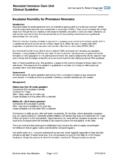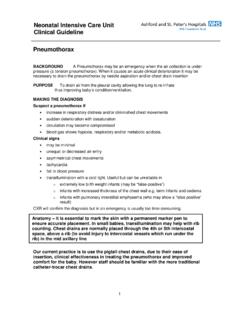Transcription of Naso-Jejunal Tube Insertion - asph.mobi
1 Naso-Jejunal tube (NJT) Insertion Introduction: A Naso-Jejunal tube is a long silastic tube which is inserted via the nostril into the stomach, through the pylorus, past the duodenum and into the proximal part of the jejunum. Once in the correct place, milk feeding can be commenced safely without the risk of reflux as the stomach is effectively bypassed. Gut peristalsis moves the feed along the small bowel where it is digested and absorbed by the child. Feeding can only be given by continuous infusion as there is no capacity for storage in the small bowel.
2 Although some medications can be given by NJT, the majority need to be given directly into the stomach for activation by gastric acid. Advice from a paediatric pharmacist may be useful. A dietician should be involved in the care of babies or children on NJT feeds to ensure adequate nutrition and hydration. Insertion of a NJT should always be carried out in hospital. Indications: Severe gastro-oesophageal reflux disease Life threatening episode of aspiration related to reflux Rarely, anatomical problems of stomach or oesophagus Risks: Small bowel perforation especially duodenal perforation Gastric bleeding NJT displacement eg back into stomach Failure of NJT to pass beyond pylorus with resultant coiling in stomach Radiation exposure from serial X-rays Equipment: Tape measure Silicone NJ tube (for suggested sizing see below).
3 Standard NG tube 5ml Feeding syringe 5ml Sterile water for injection Tape or Tegaderm dressing for fixing Duoderm for protecting face pH paper Size of NJT: Infants < 2kg will usually need size 4 or 5 Fr gastric tube Infants 2-4 kg will usually need a size 6 Fr gastric tube Children >4kg will usually need a size 8 Fr gastric tube Children >10kg will usually need a size 8 or 10 Fr gastric tube Page 1 of 5. Methods: 1. Select an appropriately sized NJT and ensure you have the correct feeding syringe to fit onto this.
4 Familiarise your self with the tube's markings for length. 2. Put the NJT in a freezer for approx 30mins before Insertion to make it slightly stiff. 3. Measure the distance for Insertion of a nasogastric tube, from nose to ear then down to xiphisternum. Record this length as distance A (the gastric tube length). 4. Measure the distance for Insertion of the Naso-Jejunal tube, from the bridge of nose down the body to the ankle with legs extended (see picture below). Record this as distance B (the jejunal tube length).
5 You can place a tape marker on the NJT at this length if you wish. 5. Lie the infant right side down and insert the NJT through the nostril as you would a gastric tube. When you reach distance A (known to be the stomach), pause and inject 2ml of sterile water through this tube. This promotes peristaltic activity. 6. With the child in the same position, advance the tube slowly until you reach distance B at the nostril (or your marker if you placed one). If you encounter resistance gently flush an extra of sterile water as you advance the tube.
6 Peristalsis should carry the NJT through the pylorus and into the small bowel with time. Secure the tube to the cheek. Do not aspirate the NJT. 7. Next insert an appropriately sized orogastric/nasogastric tube to distance A and secure to cheek. Both tubes can be inserted via same nostril if there is sufficient space. Aspirate the naso /orogastric tube and confirm presence of acid on pH. paper. There is no need to empty the stomach completely. 8. Leave the child in the same right side down lateral position for 3-4 hours to allow peristalsis to carry the NJT through the pylorus into small bowel.
7 9. Check position of both tubes with a single X-ray of chest and abdomen. A. doctor must confirm that the position is satisfactory before feeding via the NJT. commences. 10. Document length of NJT Insertion clearly on nursing charts. Ensure all staff are clear about which tube is gastric and which jejunal . Measurements: Distance A: Measure from nostril to ear and then down to the xiphisternum. This equals length A, for Insertion of a Distance A nasogastric tube into the stomach. Distance B: Measure the distance from the bridge of the nose down to an ankle with the leg fully extended.
8 This Distance B is length B, for placing a nasojejunal tube into the jejunum. Page 2 of 5. X-ray interpretation: The NJT tip should been seen to go through the pylorus and around the c-shaped duodenum. The tip should ideally lie either in the midline (over a vertebral body) or to the left of the patients midline in the jejunum (picture 1). If NJT is too far in seen to curl in small bowel loops gently withdraw as necessary. You can measure the exact distance to withdraw on the X-ray. If NJT is through the pylorus but lies short, then loosen the securing tapes and advance further as necessary (picture 2).
9 Re-X-ray to confirm final position before feeding is commenced. If NJT tube is coiled in the stomach, without going through the pylorus then remove tube and prepare for another attempt at Insertion . If the NJT has taken an unusual path within the bowel then remove the tube and discuss case with a senior colleague (picture 3). Picture 1: NJT loops in stomach and the tip lies in jejunum to the left of midline. Note the c-shaped duodenum. This is the correct position. Picture 2: NJT is looped in stomach and then passes through the pylorus but lies in 2nd part of duodenum, to the right side of the vertebral body.
10 Plan: Tube needs advancing further to reach jejunum. Page 3 of 5. Picture 3: NJT had passed through pylorus into duodenum but then has taken a very abnormal path straight down. This is not the correct position and raises suspicion of duodenal perforation. This tube needs removing immediately. Naso-Jejunal feeding instructions: 1. Ensure NJT is at the correct length at nose. 2. Ensure a gastric tube (NGT/ OGT) is also present for aspirating and administering medication. 3. Feeds should run by continuous infusion through the NJT via a pump.





